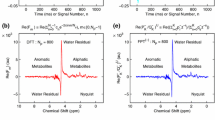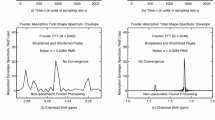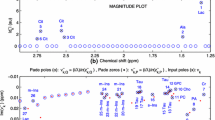Abstract
Advanced signal processing through the fast Padé transform (FPT) can enhance resolution and generates quantitative metabolic information for magnetic resonance spectroscopy (MRS). Herein, we apply both \(\hbox {FPT}^{(\pm )}\) variants to in vitro MRS data as encoded from benign and malignant ovarian cyst fluid and perform detailed analysis with several noise levels. In the presence of higher background noise, all genuine metabolites were unambiguously identified and their concentrations precisely computed, using small fractions of the total signal length by both FPT variants. In the \(\hbox {FPT}^{(-)}\), signal–noise separation was accomplished with the help of the “Stability test”, whereby the non-physical information is binned and denoised spectra are generated. In the \(\hbox {FPT}^{(+)}\) even more stringent signal–noise separation was achieved: the spurious resonances reside exclusively in the negative imaginary frequency domain, whereas the genuine content is all in the positive imaginary frequency region. Pole-zero coincidence of spurious resonance remained complete in the \(\hbox {FPT}^{(+)}\) even at higher noise levels. Via the \(\hbox {FPT}^{(+)}\), a denoised spectrum is generated automatically, without the need for the “Stability test”. The two variants \(\hbox {FPT}^{(\pm )}\) provide self-contained cross-validation of the reconstructed spectral parameters, from which the metabolite concentrations of benign and malignant ovarian cyst fluid are reliably computed. These results are particularly promising for more effective ovarian cancer diagnostics, overcoming the major obstacles that have hindered MRS from becoming the method of choice for non-invasive assessment of ovarian lesions.









Similar content being viewed by others
Notes
Serum cancer antigen, CA-125 is a protein whose presence is often associated with ovarian cancer. However, it has poor sensitivity for early stage malignancy and is also non-specific, being present in other cancers, as well as in several non-malignant conditions, including pregnancy.
In Ref. [40] the total number of benign gynecological lesions is given, and the various types described. From this description it can be deduced that at least two and at most six of these lesions were ovarian.
Abbreviations
- Ala:
-
Alanine
- au:
-
Arbitrary units
- BW:
-
Bandwidth
- Cho:
-
Choline
- Crn:
-
Creatinine
- COSY:
-
2D correlated spectroscopy
- Cr:
-
Creatine
- DWI:
-
Diffusion weighted imaging
- FFT:
-
Fast Fourier transform
- FID:
-
Free induction decay
- FPT:
-
Fast Padé transform
- Iso:
-
Isoleucine
- Glc:
-
Glucose
- Gln:
-
Glutamine
- Lac:
-
Lactate
- Lys:
-
Lysine
- MRI:
-
Magnetic resonance imaging
- MRS:
-
Magnetic resonance spectroscopy
- Met:
-
Methionine
- PLCO:
-
Prostate, lung, colon, and ovarian (trial)
- ppm:
-
Parts per million
- RMS:
-
Root-mean-square
- SCS:
-
Statistical classification strategy
- SNR:
-
Signal to noise ratio
- SNS:
-
Signal–noise separation
- Thr:
-
Threonine
- TR:
-
Repetition time
- TVUS:
-
Transvaginal ultrasound
- Val:
-
Valine
- ww:
-
Wet weight
References
M. Åkeson, A. Jakobsen, B. Zetterqvist, E. Holmberg, M. Brannström, G. Horvath, A population-based 5-year cohort study of epithelial ovarian cancer in western Sweden. Int. J. Gynecol. Cancer 19, 116–123 (2009)
V. Beral, Million Women Study Collaborators, ovarian cancer and hormone replacement therapy in the Million Women Study. Lancet 369, 1703–1710 (2007)
P. Boyle, M.E. Leon, P. Maisonneuve, P. Autier, Cancer control in women. Update 2003. Int. J. Gynecol. Obstet. 83(Supplement 1), 179–202 (2003)
J. Schildkraut, A. Alberg, E. Bandera, J. Barnholtz-Sloan, M. Bondy, M. Cote, E. Funkhouser, E. Peters, A. Schwartz, P. Terry, K. Wallace, L. Akushevich, F. Wang, S. Crankshaw, P. Moorman, A multi-center population-based case–control study of ovarian cancer in African-American women: the African American Cancer Epidemiology Study (AACES). BMC Cancer 14, 688 (2014)
J. Menczer, I. Liphshitz, M. Barchana, A decreasing incidence of ovarian carcinoma in Israel. Int. J. Gynecol. Obstet. 16, 41–44 (2006)
A. Ashworth, F. Balkwill, R.C. Bast, J.S. Berek, A. Kaye, J.A. Boyd, G. Mills, J.N. Weinstein, K. Woolley, P. Workman, Opportunities and challenges in ovarian cancer research, a perspective from the 11th ovarian cancer action/HHMT Forum, Lake Como, March 2007. Gynecol. Oncol. 108, 652–657 (2008)
M.A. Brewer, K. Johnson, M. Follen, D. Gershenson, R. Bast, Prevention of ovarian cancer: intraepithelial neoplasia. Clin. Cancer Res. 9, 20–30 (2003)
N. Wentzensen, S. Wacholder, Talc use and ovarian cancer: epidemiology between a rock and a hard place. J. Natl. Cancer Inst. 106, dju260 (2014)
F. Salehi, L. Dunfield, K. Phillips, D. Krewski, B. Vanderhyden, Risk factors for ovarian cancer: an overview with emphasis on hormonal factors. J. Toxicol. Environ. Health 11, 301–321 (2008)
P.D.P. Pharoah, The potential for risk stratification in the management of ovarian cancer risk. Int. J. Gynecol. Cancer 22, S16–S17 (2012)
N. Wentzensen, B. Trabert, Hormone therapy: short-term relief, long-term consequences. Lancet (2015). doi:10.1016/S0140-6736(14)62458-2
Å. Klint, L. Tryggvadottir, F. Bray, M. Gislum, T. Hakulinen, H. Storm, M. Enghol, Trends in the survival of patients diagnosed with cancer in female genital organs in Nordic countries. Acta Oncol. 49, 632–643 (2010)
P. Bhatti, K.L. Cushing-Haugen, K.G. Wicklund, J. Doherty, M.A. Rossing, Nightshift work and risk of ovarian cancer. Occup. Environ. Med. 70, 231–237 (2013)
S. Harlap, S.H. Olson, R.R. Barakat, T.A. Caputo, S. Forment, A.J. Jacobs, C. Nakraseive, X. Xue, Diagnostic X-rays and risk of epithelial ovarian carcinoma in Jews. Ann. Epidemiol. 12, 426–434 (2002)
E.R. Woodward, H.V. Sleightholme, A.M. Considine, S. Williamson, J.M. McHugo, D.G. Cruger, Annual surveillance by CA125 and transvaginal ultrasound for ovarian cancer in both high-risk and population risk women is ineffective. Br J. Obstet. Gynaecol. 114, 1500–1509 (2007)
P. Mohaghegh, A.G. Rockall, Imaging strategy for early ovarian cancer: characterization of adnexal masses with conventional and advanced imaging techniques. Radiographics 32, 1751–1773 (2012)
S. Bhoola, W.J. Hoskins, Diagnosis and management of epithelial ovarian cancer. Obstet. Gynecol. 107, 1399–1410 (2006)
G. Chornokur, E. Armankwah, J. Schildkraut, C. Phelan, Global ovarian cancer health disparities. Gynecol. Oncol. 129, 258–264 (2013)
N. Einhorn, R. Bast, R. Knapp, B. Nilsson, V. Zurawski, K. Sjövall, Long-term follow-up of the Stockholm screening study on ovarian cancer. Gynecol. Oncol. 79, 466–470 (2000)
R.J. Kurman, K. Visvanathan, R. Roden, T.C. Wu, IeM Shih, Early detection and treatment of ovarian cancer: shifting from early stage to minimal volume of disease based on a new model of carcinogenesis. Am. J. Obstet. Gynecol. 198, 351–356 (2008)
M. Andersen, K. Lowe, B. Goff, Value of symptom-triggered diagnostic evaluation for ovarian cancer. Obstet. Gynecol. 123, 73–79 (2014)
U. Menon, M. Griffin, A. Gentry-Maharaj, Ovarian cancer screening—current status, future directions. Gynecol. Oncol. 132, 490–495 (2014)
H. Kobayashi, Y. Yamada, T. Sado, M. Sakata, S. Yoshida, S. Kawaguchi, S. Kanayama, H. Shigetomi, S. Haruta, Y. Tsuji, S. Ueda, T. Kitanaka, A randomized study of screening for ovarian cancer: a multi-center study in Japan. Int. J. Gynecol. Cancer 18, 414–420 (2008)
F. Kong, C. Nicole White, X. Xiao, Y. Feng, C. Xu, D. He, Z. Zhang, Y. Yu, Using proteomic approaches to identify new biomarkers for detection and monitoring of ovarian cancer. Gynecol. Oncol. 100, 247–253 (2006)
I. Shapira, M. Oswald, J. Lovecchio, H. Khalili, A. Menzin, J. Whyte, L. Dos Santos, S. Liang, T. Bhuiya, M. Keogh, C. Mason, K. Sultan, D. Budman, P. Gregersen, A. Lee, Circulating biomarkers for detection of ovarian cancer and predicting cancer outcomes. Br. J. Cancer 110, 976–983 (2014)
A.E. Lokshin, The quest for ovarian cancer screening biomarkers: are we on the right road? Int. J. Gynecol. Cancer 22, S35–S40 (2012)
V. Nossov, M. Amneus, F. Su, J. Lang, J.M. Janco, S.T. Reddy, R. Farias-Eisner, The early detection of ovarian cancer: from traditional methods to proteomics: can we really do better than serum CA-125? Am. J. Obstet. Gynecol. 199, 215–223 (2008)
K.L. Taylor, R. Shelby, E. Gelmann, C. McGuire, Quality of life and trial adherence among participants in the prostate, lung, colorectal, and ovarian cancer screening trial. J. Natl. Cancer Inst. 96, 1083–1094 (2004)
P.M. McGovern, C.R. Gross, R.A. Krueger, D.A. Engelhard, J.E. Cordes, T.R. Church, False-positive cancer screens and health-related quality of life. Cancer Nurs. 27, 347–352 (2004)
V.A. Moyer, Screening for ovarian cancer: U.S. Preventive Services Task Force reaffirmation recommendation. Ann. Intern. Med. 157, 900–904 (2012)
A. Slomski, Screening women for ovarian cancer still does more harm than good. J. Am. Medical Assoc. 307, 2474–2475 (2012)
R.J. Morgan, R.D. Alvarez, D.K. Armstrong, R.A. Burger, M. Castells, L.-M. Chen, L. Copeland, M.A. Crispens, D. Gershenson, H. Gray, A. Hakam, L.J. Havrilesky, C. Johnston, S. Lele, L. Martin, U.A. Matulonis, D.M. O’Malley, R.T. Penson, S.W. Remmenga, P. Sabbatini, J.T. Santoso, R.J. Schilder, J. Schink, N. Teng, T.L. Werner, M. Hughes, M.A. Dwyer, Ovarian cancer, version 3.2012. NCCN guidelines insights. J. Natl. Compr. Canc. Netw. 10, 1339–1349 (2012)
K. Belkić, M. Cohen, M. Márquez, M. Mints, B. Wilczek, A.H. Berman, E. Castellanos, M. Castellanos, Screening of high-risk groups for breast and ovarian cancer in Europe: a focus on the Jewish population. Oncol. Rev. 4, 233–267 (2010)
I. Imaoka, T. Araki, M. Takeuchi, MRI of the female genitourinary tract, in Magnetic Resonance Volume 3 Comprehensive Biomedical Physics, ed. by Dž Belkić, K. Belkić (Elsevier, Amsterdam, 2014), pp. 221–240
K. Kinkel, Y. Lu, A. Mehdizade, M.-F. Pelte, H. Hricak, Indeterminate ovarian mass at US. Radiology 236, 85–94 (2005)
S. Zhao, J. Qiang, G. Zhang, F. Ma, S. Cai, H. Li, L. Wang, Diffusion-weighted MR imaging for differentiating borderline from malignant epithelial tumours of the ovary: pathological correlation. Eur. Radiol. 24, 2292–2299 (2014)
D. Hanahan, R.A. Weinberg, Hallmarks of cancer: the next generation. Cell 144, 646–674 (2011)
M.F. Kircher, H. Hricak, S.M. Larson, Molecular imaging for personalized cancer care. Mol. Oncol. 6, 182–195 (2012)
L.F.A.G. Massuger, P.B.J. van Vierzen, U. Engelke, A. Heerschap, R. Wevers, \(^{1}\)H magnetic resonance spectroscopy. A new technique to discriminate benign from malignant ovarian tumors. Cancer 82, 1726–1730 (1998)
S.J. Booth, M.D. Pickles, L.W. Turnbull, In vivo magnetic resonance spectroscopy of gynaecological tumors at 3.0 Tesla. Br. J. Obstet. Gynaecol. 116, 300–303 (2009)
S.W. Cho, S.G. Cho, J.H. Lee, H.-J. Kim, M.H. Lim, J.H. Kim, C.H. Suh, In vivo proton magnetic resonance spectroscopy in adnexal lesions. Korean J. Radiol. 3, 105–112 (2002)
A. Esseridou, G. Di Leo, L.M. Sconfienza, V. Caldiera, F. Raspagliesi, B. Grijuela, F. Hanozet, F. Podo, F. Sardanelli, In vivo detection of choline in ovarian tumors using 3D MRS. Invest. Radiol. 46, 377–382 (2011)
S. Hascalik, O. Celik, G. Erdem, Magnetic resonance spectral analysis of ovarian teratomas. Int. J. Gynecol. Obstet. 90, 152–152 (2005)
S. Hascalik, O. Celik, K. Sarak, M.M. Meydanli, A. Alkan, B. Mizrak, Metabolic changes in pelvic lesions: findings at proton MR spectroscopic imaging. Gynecol. Obstet. Invest. 60, 121–127 (2005)
E. Kolwijck, U.F. Engelke, M. van der Graaf, A. Heerschap, J. Henk, H.J. Blom, M. Hadfoune, W.A. Buurman, L.F. Massuger, R.A. Wevers, N-acetyl resonances in in vivo and in vitro NMR spectroscopy of cystic ovarian tumors. NMR Biomed. 22, 1093–1099 (2009)
M.A. McLean, A.N. Priest, I. Joubert, D.J. Lomas, M.Y. Kataoka, H. Earl, R. Crawford, J.D. Brenton, J.R. Griffiths, E. Sala, Metabolic characterization of primary and metastatic ovarian cancer by 1H-MRS in vivo at 3T. Magn. Reson. Med. 62, 855–861 (2009)
T. Okada, M. Harada, K. Matsuzaki, H. Nishitani, T.J. Aono, Evaluation of female intrapelvic tumors by clinical proton MR spectroscopy. Magn. Reson. Imaging 13, 912–917 (2001)
P. Stanwell, P. Russell, J. Carter, S. Pather, S. Heintze, C. Mountford, Evaluation of ovarian tumors by proton magnetic resonance spectroscopy at three Tesla. Invest. Radiol. 43, 745–751 (2008)
M. Takeuchi, K. Matsuzaki, M. Harada, Preliminary observations and diagnostic value of lipid peak in ovarian thecomas/fibrothecomas using in vivo proton MR spectroscopy at 3T. J. Magn. Reson. Imaging 36, 907–911 (2012)
E.A. Boss, S.H. Moolenaar, L.F. Massuger, H. Boonstra, U.F. Engelke, J.G. de Jong, R.A. Wevers, High-resolution proton nuclear magnetic resonance spectroscopy of ovarian cyst fluid. NMR Biomed. 13, 297–30 (2000)
J.C. Wallace, G.P. Raaphorst, R.L. Somorjai, C.E. Ng, M. Fung Kee Fung, M. Senterman, I.C. Smith, Classification of 1H MR spectra of biopsies from untreated and recurrent ovarian cancer using linear discriminant analysis. Magn. Reson. Med. 38, 569–576 (1997)
I.C. Smith, D.E. Blandford, Diagnosis of cancer in humans by 1H NMR of tissue biopsies. Biochem. Cell. Biol. 76, 472–476 (1998)
C.E. Mountford, S. Doran, C.L. Lean, P.L. Russell, Proton MRS can determine the pathology of human cancers with a high level of accuracy. Chem. Rev. 104, 3677–3704 (2004)
L. Gluch, Magnetic resonance in surgical oncology: II-literature review. ANZ. J. Surg. 75, 464–470 (2005)
J.K. Nicholson, I.D. Wilson, High resolution proton magnetic resonance spectroscopy of biological fluids. Prog. NMR Spectrosc. 21, 449–501 (1989)
Dž. Belkić, Strikingly stable convergence of the fast Padé transform (FPT) for high resolution parametric and non-parametric signal processing of Lorentzian and non-Lorentzian spectra. Nucl. Instrum. Methods Phys. Res. A 525, 366–371 (2004)
Dž. Belkić, Quantum Mechanical Signal Processing and Spectral Analysis (Institute of Physics Publishing, Bristol, 2005)
Dž. Belkić, K. Belkić, Signal Processing in Magnetic Resonance Spectroscopy with Biomedical Applications (Taylor & Francis, London, 2010)
Dž. Belkić, Exact signal–noise separation by Froissart doublets in the fast Padé transform for magnetic resonance spectroscopy. Adv. Quantum Chem. 56, 95–179 (2009)
Dž. Belkić, K. Belkić, The general concept of signal–noise separation (SNS). J. Math. Chem. 45, 563–597 (2009)
K. Belkić, Resolution performance of the fast Padé transform: potential advantages for magnetic resonance spectroscopy in ovarian cancer diagnostics. Nucl. Instrum. Methods Phys. Res. A 580, 874–880 (2007)
Dž. Belkić, K. Belkić, Mathematical modeling applied to an NMR problem in ovarian cancer detection. J. Math. Chem. 43, 395–425 (2008)
Dž. Belkić, K. Belkić, Magnetic resonance spectroscopy with high-resolution and exact quantification in the presence of noise for improving ovarian cancer detection. J. Math. Chem. 50, 2558–2576 (2012)
Dž. Belkić, K. Belkić, Resolution enhancement as a key step towards clinical implementation of Padé-optimized magnetic resonance spectroscopy for diagnostic oncology. J. Math. Chem. 51, 2608–2637 (2013)
Dž. Belkić, K. Belkić, Strategic steps for advanced molecular imaging with magnetic resonance-based diagnostic modalities. Technol. Cancer Res. Treat. 14, 119–142 (2015)
A.C. Ojo, The Analysis and Automatic Classification of Nuclear Magnetic Resonance Signals. PhD Thesis. (The University of Edinburgh, 2010), Edinburgh Research Archive, http://hdl.handle.net/1842/4109
Dž. Belkić, Analytical continuation by numerical means in spectral analysis using the fast Padé transform (FPT). Nucl. Instrum. Methods Phys. Res. A 525, 372–378 (2004)
Dž. Belkić, Exact quantification of time signals in Padé-based magnetic resonance spectroscopy. Phys. Med. Biol. 51, 2633–2670 (2006)
K. Glunde, J. Jiang, S.A. Moestue, I.S. Gribbestad, MRS/MRSI guidance in molecular medicine: targeting choline and glucose metabolism. NMR Biomed. 24, 673–690 (2011)
Dž. Belkić, K. Belkić, Proof-of-the-concept study on mathematically optimized magnetic resonance spectroscopy for breast cancer diagnostics. Technol. Cancer Res. Treat. (2014). doi:10.1177/1533034614547446
Dž. Belkić, K. Belkić, Padé optimization of noise-corrupted magnetic resonance spectroscopic time signals from fibroadenoma of the breast. J. Math. Chem. 52, 2680–2713 (2014)
Dž. Belkić, K. Belkić, Optimized spectral analysis in magnetic resonance spectroscopy for early tumor diagnostics. J. Phys. Conf. Ser. 565, 012002 (2014). doi:10.1088/1742-6596/565/1/012002
E. Iorio, D. Mezzanzanica, P. Alberti, F. Spadaro, C. Ramoni, S. D’Ascenzo, D. Millimaggi, A. Pavan, V. Dolo, S. Canavari, F. Podo, Alterations of choline phospholipid metabolism in ovarian tumor progression. Cancer Res. 65, 9369–9376 (2005)
Dž. Belkić, K. Belkić, Molecular imaging in the framework of personalized cancer medicine. Isr. Med. Assoc. J. 15, 665–672 (2013)
Dž. Belkić, K. Belkić, The role of optimized molecular imaging in personalized cancer medicine. Diag. Imaging Eur. 30, 28–31 (2014)
M. Mescher, H. Merkle, J. Kirsch, M. Garwood, R. Gruetter, Simultaneous in vivo spectral editing and water suppression. NMR Biomed. 11, 266–272 (1998)
P.A. Bottomley, The trouble with spectroscopy papers. J. Magn. Reson. Imaging 2, 1–8 (1992)
Acknowledgments
This work was supported by King Gustav the 5th Jubilee Fund, Cancerfonden, the Karolinska Institute Research Fund and FoUU through Stockholm County Council to which the authors are grateful.
Conflict of interest
The authors declare that they have no conflict of interest.
Author information
Authors and Affiliations
Corresponding author
Rights and permissions
About this article
Cite this article
Belkić, D., Belkić, K. How the fast Padé transform handles noise for MRS data from the ovary: importance for ovarian cancer diagnostics. J Math Chem 54, 149–185 (2016). https://doi.org/10.1007/s10910-015-0555-x
Received:
Accepted:
Published:
Issue Date:
DOI: https://doi.org/10.1007/s10910-015-0555-x




